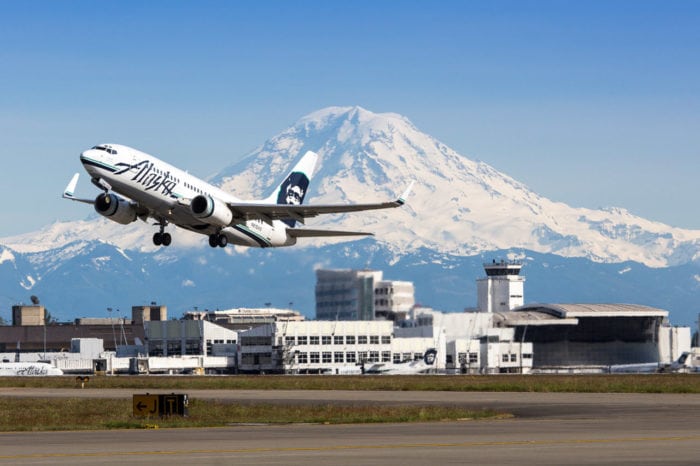
Central Terminal at Sea-Tac Airport. Photo: Port of Seattle image by Don Wilson.
Under a budget proposal released May 23 by President Donald Trump, the FAA’s current operational structure would see its management of the U.S. air traffic control (ATC) system separated from its role as the nation’s aviation safety regulator by 2021. According to the 47-page budget proposal released by the White House, if the president’s budget is approved, the ATC system would be managed by an independent non-governmental organization.
Transportation lawmakers have proposed a similar separation of ATC from the FAA in recent years, only to see those proposals failing to amount to become reality, with Congress instead passing consecutive short-term funding bills for the FAA. However, now, with support from the White House, the U.S. could see its aviation governing structure become similar to other nations such as Canada, most European nations and Australia among others that use private companies as their individual air navigation service providers (ANSP).
The newly released budget proposal notes that separation is necessary to accommodate for growth in air traffic volume and to “meet the demands of aviation users.” Separating management of air traffic from the FAA is also projected to produce a “cap reduction in discretionary spending of $72.8 billion, and reduction in aviation excise taxes of $115.6 billion,” the budget says.
More detail on the proposed FAA structural changes emerged during a House transportation committee hearing May 17, where lawmakers listened to expert testimony from the president of the National Air Traffic Controllers Assn. (NATCA) among others. In recent years, the most support for the proposed change has come from organizations, such as Airlines for America (A4A), that represent U.S. commercial airlines. In contrast, most opposition has been voiced by organizations representing the business and general aviation communities, such as the National Business Aviation Assn. (NBAA).
House Transportation Committee Chairman Bill Shuster, who originally proposed separating ATC from FAA control February 2016, provided the hearing’s biggest critique of the FAA, including its ongoing air transportation modernization project, NextGen.
“Congress has provided more than $7.4 billion dollars for NextGen since 2004. Results are the problem. According to the FAA’s own calculations, the return on the taxpayers’ $7.4 billion investment has only been about $2 billion in benefits. And we’ve still got a long way to go,” Shuster said.
Shuster also noted that the lawmakers haven’t helped much in terms of providing steady, long-term funding for the FAA, as there has been no Transportation Appropriations bill since 2006. Since then, Congress has passed 42 continuing resolutions, and 23 short-term extensions for the FAA over a five-year period prior to passing a long-term FAA authorization bill in 2012.
Joseph W. Brown, president of Hartzell Propeller, general aviation pilot and board member of the General Aviation Manufacturers Assn. (GAMA), provided the hearing’s strongest opposition to the proposal to separate ATC from FAA control. He cited a 2015 Dept. of Transportation Inspector General report that was critical of one of the biggest reasons that Shuster has provided in support of creating a new ANSP in the U.S.
In support of the separation, Shuster and others have noted that Canada’s ANSP, Nav Canada, provides an example of how separation has been successfully accomplished by other countries in the past. However, the report cited by Brown notes that ANSPs examined by DOT IG in Germany, France, Canada and the U.K. do not embark on large modernization efforts. Nav Canada, for example, has an annual budget of approximately $120 million, and considers a “large” acquisition to be $10 million.
Comparatively, in February 2016, the Dept. of Transportation (DOT) issued a $15.83 billion budget request for fiscal year 2016, including $9.9 billion for operations; $2.85 billion for facilities and equipment (F&E); $166 million for research, engineering and development (RE&D); and $2.9 billion in Airport Improvement Program (AIP) grants. This included proposed NextGen funding totaling $956 million, distributed among F&E programs ($845 million), RE&D ($61 million) and operations activities ($51 million).
“Proponents of transitioning the U.S. [air traffic organization] ATO to a co-op system also argue that the entity will facilitate the pace of modernization because it can borrow on its assets turned over by taxpayers in order to invest in new or emerging technology. It is hard to imagine something more economically hazardous to the American people than an ANSP acting as a venture capitalist, potentially competing with private companies and exposing its healthy balance sheet of (our) $20B in assets to high risk tech investments,” said Brown.
The FAA’s current funding bill expires September 30, 2017, and the House transportation committee expects to hold one additional hearing on this issue before then. Lawmakers are expected to vote on the legislation within the next few months.